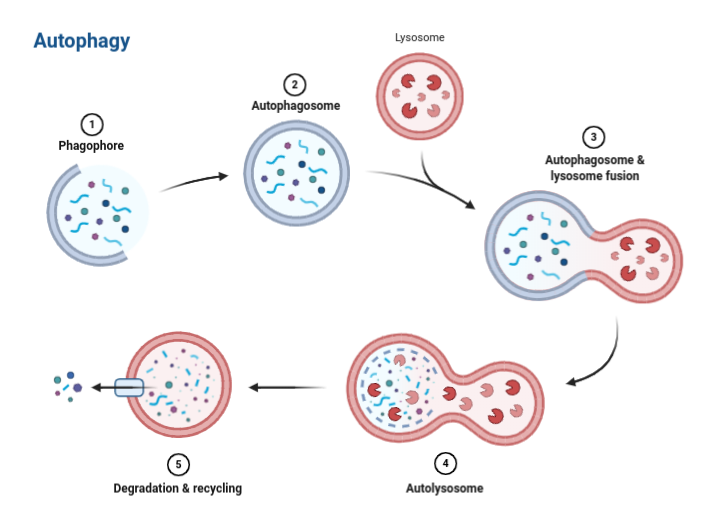
Define the Autophagy?
Answer
466.8k+ views
Hint:- Lysosomes are membrane-bound organelles that usually comprise certain hydrolytic enzymes. These cell organelles contain about 40 different types of hydrolytic enzymes which help in the intracellular digestion process. The lysosomal digestion is further classified as heterophagy and autophagy.
Complete Answer:-The word ‘auto’ means ‘self’ and ‘phagy’ means ‘eating’. Thus, collectively autophagy can be referred to as the process of self- digestion.
Autophagy generally begins with the formation of a phagophore. Photophores are formed from a cup-shaped membrane that expands into a double membrane-bound structure called autophagosome, which surrounds a portion of the cytoplasm in a cell. The entire autophagosome then fuses with lysosome which contains acid hydrolase enzymes. These enzymes then cause hydrolysis of the inner membrane belonging to autophagosomes, ultimately resulting in degradation of the material. As a result, the macromolecules produced during this digestion process are thus released, and recycled within the cytosol. Some lysosome also helps in removing undigested contents by the means of exocytosis.
This process of self-destruction helps in removing misfolded proteins, damaged cell organelles and intracellular pathogens helping to maintain a healthy environment inside the body. Thus, it is said to be a survival mechanism adopted by cells to combat unfavorable or unhealthy situations on their own. However, a lack of regulation can even cause apoptotic or programmed cell death.

Note:- Autophagy is an intracellular degradation process of cytoplasmic constituents within lysosomes. It helps to maintain the proper functioning of the cell by removing unwanted and harmful materials from the cell. Autophagy can even be seen at the time of programmed cell death.
Complete Answer:-The word ‘auto’ means ‘self’ and ‘phagy’ means ‘eating’. Thus, collectively autophagy can be referred to as the process of self- digestion.
Autophagy generally begins with the formation of a phagophore. Photophores are formed from a cup-shaped membrane that expands into a double membrane-bound structure called autophagosome, which surrounds a portion of the cytoplasm in a cell. The entire autophagosome then fuses with lysosome which contains acid hydrolase enzymes. These enzymes then cause hydrolysis of the inner membrane belonging to autophagosomes, ultimately resulting in degradation of the material. As a result, the macromolecules produced during this digestion process are thus released, and recycled within the cytosol. Some lysosome also helps in removing undigested contents by the means of exocytosis.
This process of self-destruction helps in removing misfolded proteins, damaged cell organelles and intracellular pathogens helping to maintain a healthy environment inside the body. Thus, it is said to be a survival mechanism adopted by cells to combat unfavorable or unhealthy situations on their own. However, a lack of regulation can even cause apoptotic or programmed cell death.

Note:- Autophagy is an intracellular degradation process of cytoplasmic constituents within lysosomes. It helps to maintain the proper functioning of the cell by removing unwanted and harmful materials from the cell. Autophagy can even be seen at the time of programmed cell death.
Recently Updated Pages
How do you factor x2 + x 20 0 class 9 maths CBSE

How do you solve y6x and 2x+3y20 using substitutio class 9 maths CBSE

Chipko movement originated in Gopeshwar in A 1953 B class 9 biology CBSE

The adjacent sides in the parallelogram are supplementary class 9 maths CBSE

The compound used in plastic industry is A Vinyl acetate class 9 chemistry CBSE

How do you solve for y in 2left y dfrac12 right 4left class 9 maths CBSE

Trending doubts
Types of lever in which effort is in between fulcrum class 12 physics CBSE

Distinguish between esterification and saponification class 12 chemistry CBSE

Which are the Top 10 Largest Countries of the World?

A two input XOR Gate produces a high output only when class 12 physics CBSE

Give five points to show the significance of varia class 12 biology CBSE

Which is the correct genotypic ratio of mendel dihybrid class 12 biology CBSE




